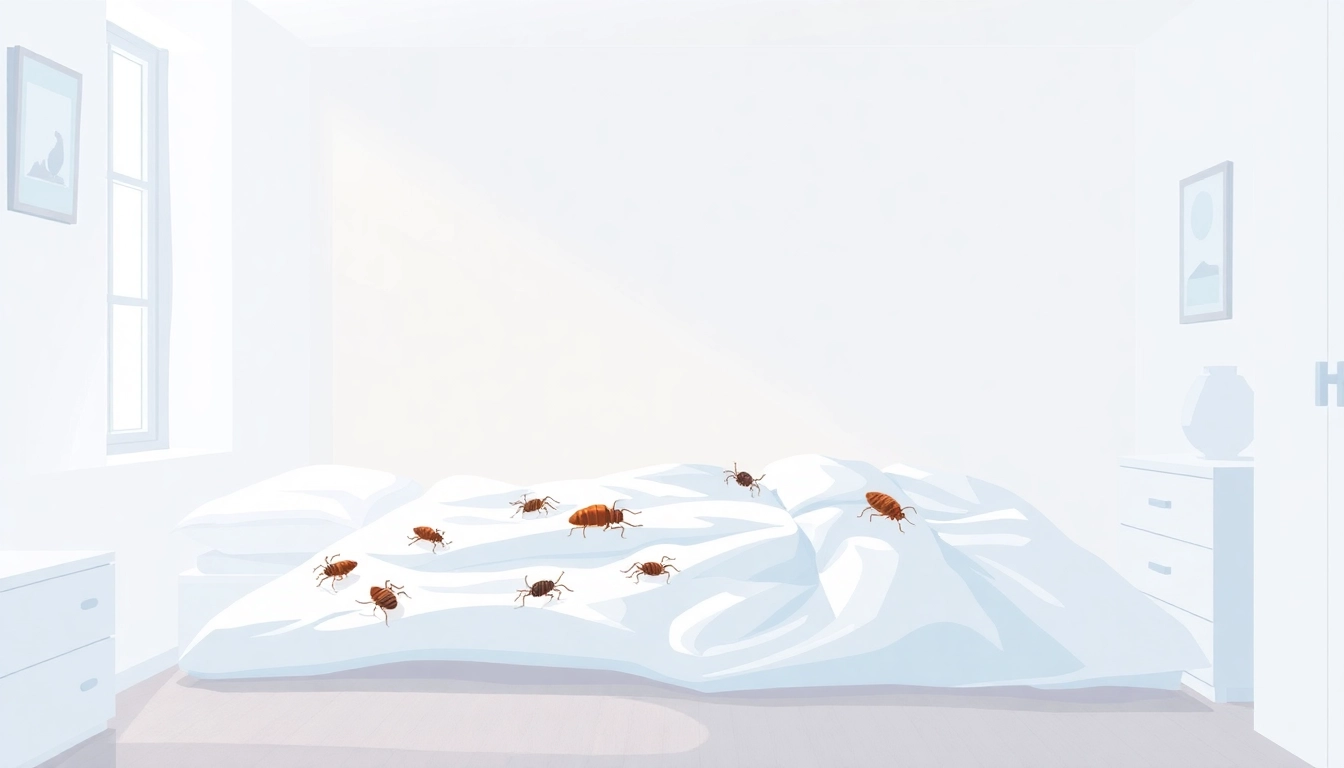Understanding Bed Bugs and Their Impact
What are Bed Bugs?
Bed bugs are small, brownish insects that belong to the Cimicidae family. They typically measure between 1 to 7 millimeters long and have a flat, oval shape, which allows them to hide easily in the crevices of beds, furniture, and walls. These nocturnal pests feed primarily on the blood of humans and other warm-blooded hosts. Once they have fed, their bodies swell and become a reddish color, making it easier for individuals to identify them in their environment. The resurgence of bed bugs in the 21st century has raised concerns globally, as these pests can easily be transported via luggage, clothing, and used furniture, leading to widespread infestations.
Signs of Infestation
Identifying a bed bug infestation early is crucial for effective bed bug removal. Common signs include:
- Bed Bug Bites: Small, itchy welts on the skin, often appearing in a line or cluster, can signify bed bug feeding.
- Blood Stains: Tiny dark or brown stains on sheets, mattresses, or walls may indicate that bed bugs have been feeding.
- Dark Spots: Bed bug excrement appears as dark spotting or stains on various surfaces.
- Egg Casings: Look for small, pale shells that indicate freshly hatched bedbugs.
- Musty Odor: A distinct smell similar to that of overripe raspberries may be emitted from bed bugs when they are in large numbers.
Health Risks and Concerns
While bed bugs do not transmit diseases, their bites can lead to serious discomfort and secondary skin infections due to scratching. Some individuals may develop more significant allergic reactions to the bites, leading to excessive itching and swelling. Additionally, the psychological stress from sleepless nights and anxiety over infestations can significantly affect a person’s mental health. Understanding these impacts is imperative for motivating timely action for bed bug extermination.
Effective Bed Bug Removal Techniques
Heat Treatments and Their Benefits
Heat treatments are among the most effective methods for killing bed bugs at all life stages, from eggs to adults. This method involves raising the temperature of affected areas to levels above 120°F (49°C) for a sustained period, ensuring that bed bugs and their eggs are eradicated. Benefits of heat treatments include:
- Comprehensive Reduction: Heat penetrates into mattresses, upholstery, and wall voids, ensuring thorough extermination.
- Chemical-Free: This method is safer for families and pets, as it eliminates the need for harmful pesticides.
- Single Treatment: Often, only one heat treatment is necessary to eliminate the entire infestation, saving time and resources.
Chemical Options for Bed Bug Extermination
Chemical treatments involve the application of various insecticides designed to kill bed bugs. This can be a standalone method or part of an integrated pest management (IPM) strategy. Common chemicals used include pyrethroids and neonicotinoids. The advantages and challenges of chemical treatments are:
- Fast-Acting: Chemical treatments can quickly reduce bed bug populations.
- Variety of Formulations: Sprays, powders, and foggers provide options for different applications.
- Resistance Issues: Some bed bugs may have developed resistance to commonly used chemicals, making them less effective in certain cases.
DIY vs. Professional Bed Bug Removal
When it comes to bed bug removal, homeowners face the choice between DIY solutions and hiring professional exterminators. While DIY methods can be cost-effective, they may not provide comprehensive results due to the complexity of bed bug behavior and hiding spots. Key differences between DIY and professional services include:
- Effectiveness: Professionals come equipped with advanced techniques and equipment that allow them to reach and eliminate bed bugs in hidden areas.
- Time and Labor: DIY methods can be labor-intensive and time-consuming without guaranteed results, while professionals often complete treatments swiftly.
- Long-Term Solutions: Pest control experts can offer insights into preventing future infestations, which DIY methods may overlook.
Preparing Your Home for Treatment
Steps to Take Before Extermination
Preparation is key to ensuring effective bed bug removal. Homeowners should take the following steps before treatment:
- Declutter: Remove excess items from rooms, particularly those near the bed and furniture, to allow for effective treatment.
- Vacuum Thoroughly: Use a vacuum to clean floors, carpets, and upholstery; remember to dispose of the vacuum bag immediately.
- Isolate Affected Items: Place infested items in plastic bags to prevent bed bugs from spreading to other areas.
How to Safely Wash Fabrics
Washing fabrics properly is essential to eliminate bed bugs and their eggs. Follow these guidelines:
- Hot Water Wash: Use hot water (at least 120°F or 49°C) for washing bed linens, clothing, and any other washable items.
- High-Heat Drying: Dry these items in a dryer on high heat setting for at least 30 minutes to effectively kill remaining bed bugs.
- Storage: Store clean items in sealed bags until after the treatment to prevent re-infestation.
Creating a Treatment Plan
Having a clear plan in place can facilitate a thorough extermination process. Consider including:
- Scheduling Treatments: Coordinate when treatments will occur and prepare your home accordingly.
- Follow-Up Inspections: Plan for follow-up visits to ensure effectiveness and monitor for any signs of returning bed bugs.
- Maintain Documentation: Keep records of treatments and observations for reference in the future.
Post-Removal Maintenance
Preventing Future Infestations
Once bed bugs have been removed, maintaining a bed-bug-free environment is crucial. Here are effective strategies:
- Regular Inspections: Routinely check for signs of bed bugs, especially after travel or acquiring used furniture.
- Protective Covers: Use bed bug-proof mattress encasements to shield mattresses and box springs.
- Be Cautious When Traveling: Inspect hotel rooms and keep luggage elevated off the floor to reduce the risk of bringing bed bugs home.
Monitoring Your Home
Effective monitoring can help catch bed bug problems early. Consider:
- Bed Bug Monitors: Use commercially available monitors around beds and furniture to catch early signs of bed bugs.
- Frequent Vacuuming: Maintain a regular vacuuming schedule to help capture stray bed bugs and eggs.
- Maintain a Clean Environment: Regular cleaning can help deter infestations and allow for easier detection of bugs.
Best Practices for Bed Bug Safety
Safety should always be prioritized when dealing with bed bugs. Some effective practices include:
- Use Protective Gear: When handling infested items, consider wearing gloves and masks to minimize direct exposure.
- Careful Disposal: If you need to discard infested items, seal them in plastic bags to prevent spreading bed bugs.
- Consult Professionals: If unsure about any procedures or handling chemicals, reach out to pest control professionals.
Cost of Bed Bug Removal Services
Evaluating Pest Control Options
Costs for bed bug removal services can vary. Analyzing different options is essential. Some aspects to consider include:
- Type of Treatment: Heat treatments might come at a different price point compared to chemical treatments.
- Size of Infestation: Larger, more widespread infestations typically incur higher treatment costs.
- Service Guarantees: Some companies offer guarantees for their treatments, which could provide peace of mind and save money in the long run.
Budgeting for Professional Help
When budgeting for bed bug removal, consider the following:
- Get Quotes: Reach out to multiple pest control providers for estimates; this can help find competitive rates.
- Check for References: Ensure the company has positive reviews and a solid reputation in dealing with bed bugs.
- Consider Long-Term Costs: Invest in a reliable treatment plan now can save money by preventing future infestations and treatments.
Understanding Service Guarantees
Many pest control services offer guarantees for their treatments, which often cover follow-ups if infestations persist. Some important factors in evaluating guarantees include:
- Duration of Guarantee: Check how long the guarantee is valid after the initial treatment.
- Conditions of Guarantee: Understand what actions might void the guarantee, such as not following post-treatment instructions.
- Success Rates: Ask about the company’s success rates in handling bed bug infestations; reputable companies should have data to support their claims.



